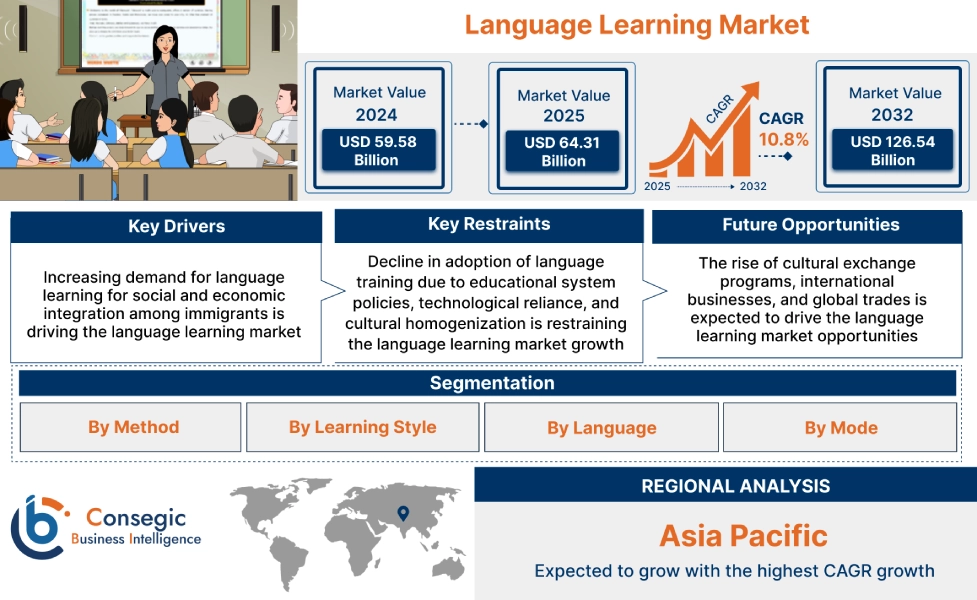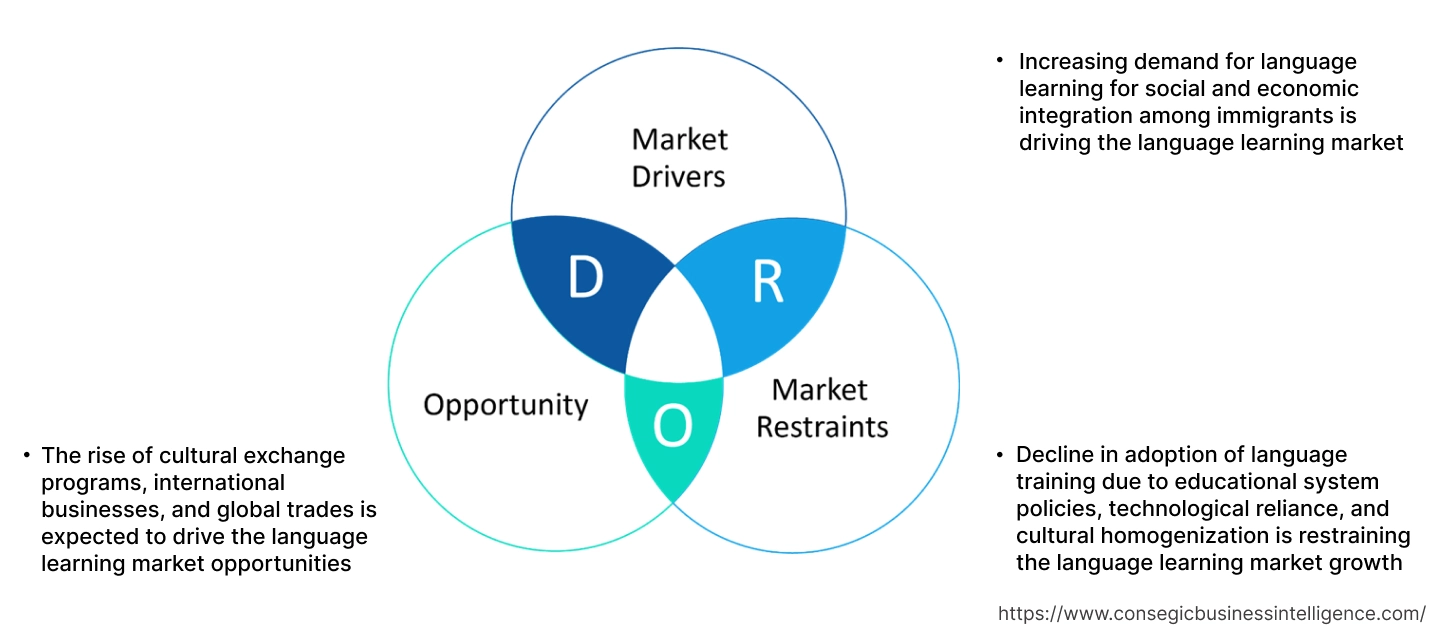Language Learning Market Size:
Language learning Market size is estimated to reach over USD 126.54 Billion by 2032 from a value of USD 59.58 Billion in 2024 and is projected to grow by USD 64.31 Billion in 2025, growing at a CAGR of 10.8% from 2025 to 2032.
Language Learning Market Scope & Overview:
Language learning refers to the process of understanding the structure and rules of various languages to speak, read, write, and listen through formal education and online tutorials. Moreover, individuals learn various languages for a variety of reasons, such as enhanced communication, increased career prospects, cultural understanding, and cognitive benefits. Additionally, learning a language helps individuals improve memory, cognitive flexibility, and problem-solving ability as it engages individuals with vocabulary and grammar structures. Thus, language training benefits individuals to expand their perspective and sharpen their decision-making power.
How is AI Transforming the Language Learning Market?
Artificial Intelligence is transforming the language learning market by making education more personalized, engaging, and accessible. AI-driven platforms analyze learners progress, pronunciation, and comprehension to create adaptive lessons that match individual learning speeds and styles. Natural language processing (NLP) enables real-time speech recognition and feedback, helping users improve fluency and accent accuracy. Furthermore, machine learning algorithms also recommend targeted exercises and track improvement over time, enhancing retention and motivation. Additionally, AI-powered chatbots and virtual tutors provide interactive conversation practice anytime, anywhere. For educators, AI offers data-driven insights into learner performance and curriculum optimization. Overall, AI is revolutionizing language learning by combining personalization, automation, and continuous feedback to improve communication skills.
Language Learning Market Dynamics - (DRO) :
Key Drivers:
Increasing demand for language learning for social and economic integration among immigrants is driving the language learning market
There is a rise in the adoption of language learning among various immigrants as there is a need for social interaction, which includes navigating daily life, accessing services, and building relationships. Moreover, being able to communicate in the host country’s language leads to higher career prospects. Additionally, government policies offer various programs to support language education for immigrants to promote the importance of language training. Furthermore, there are various ways of learning languages, such as classroom-based learning, technology-enhanced learning, multi-model and experiential learning, and others.
- For instance, according to Open Doors Report on International Educational Exchange, 67,924 students actively studied intensive English programs in the U.S in 2023.
Thus, as per the language learning market analysis, the above factors are driving the language learning market size.
Key Restraints:
Decline in adoption of language training due to educational system policies, technological reliance, and cultural homogenization is restraining the language learning market growth
Language learning is a process by which individuals acquire the capacity to perceive and comprehend language. However, there is a decline in the adoption of language training due to various factors such as lack of relevance, teaching methodologies, and rigid standardization. Moreover, government policies offer a limited number of languages in their curriculum, which further restricts learners' access to various languages and their cultures. Additionally, over-reliance on technological tools limits the interaction with native speakers, which further makes it difficult to communicate with native speakers. Further, limited exposure to various languages hinders the individual's interest in perceiving the value of learning languages, specifically less globally dominant languages. Thus, the above factors are restraining the language learning market growth.
Future Opportunities :
The rise of cultural exchange programs, international businesses, and global trades is expected to drive the language learning market opportunities
Several universities offer cultural exchange programs to foster learning and engagement with different linguistic and cultural contexts. Moreover, as business expands globally, there is a need for employees who can communicate efficiently in different languages. Additionally, globalization significantly increases the need for language training in international business.
- For instance, the Indian Council of Philosophical Researchprovides Indo French cultural exchange program. Moreover, the institute sends one scholar for one month to Paris every year to carry out research work.
Thus, as per the analysis, the rise of cultural exchange programs, international business, and global trades are expected to drive the language learning market opportunities during the forecast period.
Language Learning Market Segmental Analysis :
By Method:
Based on method, the market is segmented into adaptive learning, access extensive material, learning applications, game-based learning, distance learning and others.
Trends in method:
- There is a rising demand and adoption of learning applications due to its flexibility and enhanced efficiency, in turn driving the language learning market.
- Factors including improved flexibility, increased convenience, personalized learning, and technological advancements are key trends driving the utilization of distance learning.
Learning applications segment accounted for the largest revenue in the overall language learning market share in 2024.
- Learning application refers to a software program that is particularly designed to help individuals with on-device language training.
- Moreover, learning applications facilitate easy access, interactive and engaging elements, and better understanding of context to increase the effectiveness of language training for individuals.
- Additionally, learning applications include various progress monitoring features, which allows users to track their progress and gain better understanding of their progress journey.
- For instance, in September 2024, Duolingo, a language learning app, unveiled its artificial powered innovations such as video call and adventures. Moreover, this feature allows learners to participate in conversations with duolingo’s characters.
- Thus,increasing advancements and interactive assessments associated with learning application segment are accelerating the language learning market size.
Distance learning segment is anticipated to register the fastest CAGR growth during the forecast period.
- Distance learning refers to a way of learning that does not require physical presence at a university or institution. Moreover, there are two types of distance learning such as synchronous and asynchronous.
- Synchronous refers to real-time interaction between instructors and learners, particularly on video conferencing software, whereas asynchronous distance learning allows learners flexibility to access materials and complete assessments at their own pace.
- For instance, Symbiosis Institute for Foreign and India Languages (SIFIL) offers distance learning for various foreign languages on different proficiency levels. Moreover, SIFIL offers wide range of languages, real-life practices, and interactive learning sessions for individuals.
Therefore, the increasing utilization of distance learning is expected to propel the market during the forecast period.
By Learning Style:
Based on learning style, the market is segmented into visual, auditory, reading, kinaesthetic, analytical, and others.
Trends in learning style:
- The rising trend in the adoption of reading learning styles for improved retention, strong language skills, and active reading techniques is driving the market.
- The increasing adoption of visual learning style is driven by factors such as detailed-oriented approach, emphasis on logic and structures, and cognitive abilities, among others.
Reading segment accounted for the largest revenue share in the overall language learning market share in 2024.
- In language training, reading learning style refers to acquiring the content through written texts and actively engaging with it.
- Moreover, reading language style emphasizes the use of reading comprehension, note-taking, summarizing, and others.
- Additionally, there are various benefits of reading style, such as vocabulary expansion, mental simulation, stress reduction, and others.
- For instance, Harvard offers a summer language program, which provides reading courses in various languages such as French, German, Spanish, and others.
- Thus, the rising adoption of reading-based learning style due to various factors such as vocabulary development, strong reading skills, and others is driving the market.
Visual segment is anticipated to register the fastest CAGR growth during the forecast period.
- In language training, visual mode refers to the use of images, visuals, and design elements to represent concepts that are visually appealing to the learners.
- Moreover, visual mode offers images, graphics, videos, and animations to enhance learning and increase engagement of the learners.
- For instance, Duolingoutilizes Rive, a web-based tool, which helps to generate real-time interactive animations and designs to make language training experience more engaging for users.
- Therefore, the increasing utilization of visual modes for learning languages is expected to propel the market during the forecast period.
By Language:
Based on language, the market is segmented into English, Mandarin Chinese, Spanish, German, French, and others.
Trends in the language:
- Factors including global reach, rich cultural heritage, and career prospects are driving the language learning market trends.
English segment accounted for the largest revenue share of 52.32% in the overall market in 2024.
- English language plays a crucial role in international communication as it is the most common language used for communication between people from different linguistic backgrounds.
- Moreover, individuals are expected to be proficient in English as it is essential for professional careers, higher education, and international collaboration.
- For instance, according to the Institute of International Education Inc., 38% of the total population of students in the Asia-pacific region are studying in the U.S. in 2023. This facilitates the need to learn the English language.
- Therefore, the rising adoption of language courses to learn English language is further driving the market growth.
Spanish segment is anticipated to register the fastest CAGR growth during the forecast period.
- Spanish is the official language of Spain, Mexico, and other countries of South and Central America.
- Moreover, Spanish plays a crucial role in international business, cultural exchange, and trade, making it a crucial asset for individuals and professionals seeking career opportunities.
- For instance, Babble, a language learning app, offers Spanish courses in its offerings. Additionally, they offer courses in both European Spanish and Latin American Spanish.
- Therefore, the rising demand for Spanish language is increasing the adoption of language training, in turn propelling the market.
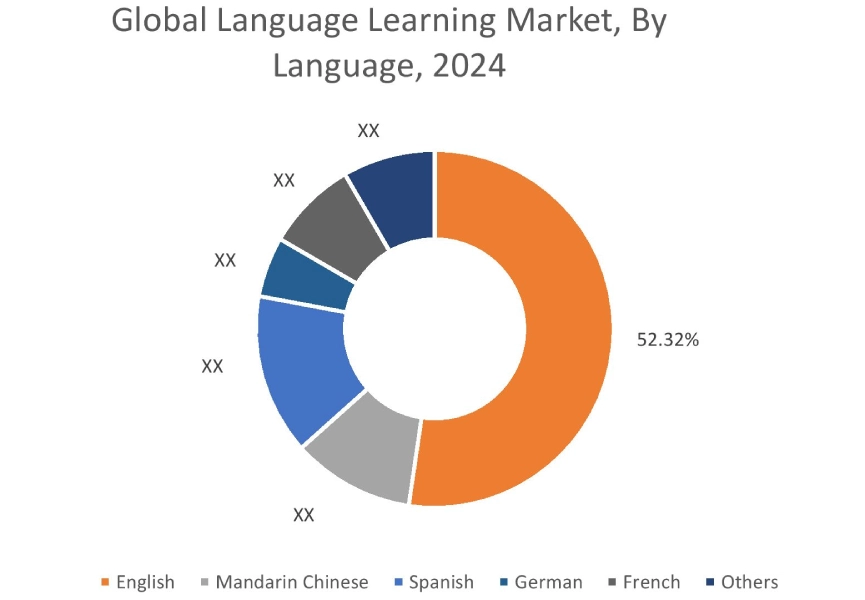
By Mode:
Based on mode, the market is segmented into online and offline.
Trends in the mode:
- Factors including improved accessibility, flexibility, and uninterrupted learning are driving the online language learning market trends.
Offline segment accounted for the largest revenue in the overall market in 2024.
- In language training, offline learning refers to any learning activity that does not require an internet connection and is conducted in person.
- Moreover, one of the key benefits of offline language training is that it provides a structured environment where learners can have dynamic interactions with their tutors.
- For instance, in December 2024, State College of Florida launched a new English language institute for individuals whose first language is not English.
- Therefore, the rising developments related to the offline learning segment are driving the language learning market.
Online segment is anticipated to register the fastest CAGR growth during the forecast period.
- Online learning, also known as e-learning, utilizes various websites, apps, and virtual classes, which offer flexibility as learners can practice anywhere.
- Moreover, online platform provides various interactive resources such as videos, puzzles, and forums to enhance the learning experience.
- Additionally, artificial intelligence-powered chatbots and virtual tutors engage learners in one-on-one lectures, providing personalised results.
- For instance, in September 2024, Aspire, a digital and virtual classroom for English language training, was offered by Learnlight, in collaboration with Oxford University.
- Therefore, the above developments related to online segment are driving the language learning market expansion.
Regional Analysis:
The regions covered are North America, Europe, Asia Pacific, the Middle East and Africa, and Latin America.
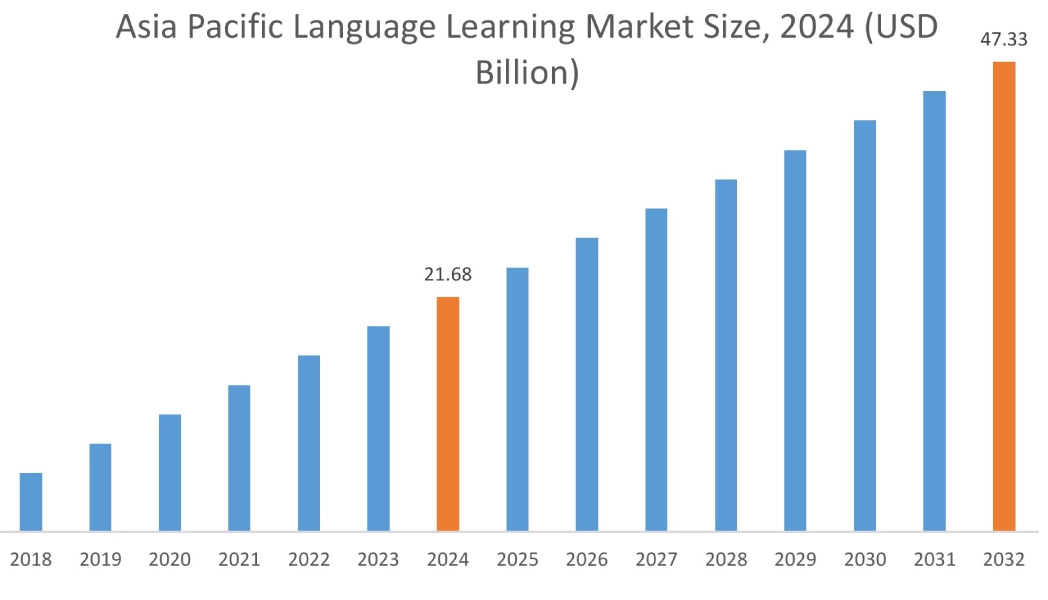
Asia Pacific region was valued at USD 21.68 Billion in 2024. Moreover, it is projected to grow by USD 23.46 Billion in 2025 and reach over USD 47.33 Billion by 2032. Out of this, China accounted for the maximum revenue share of 34.76%. As per the language learning market analysis, there is an increasing adoption of learning applications for personalised learning, flexibility, and enhanced collaboration in the Asia-Pacific region. Additionally, factors including the rising adoption of distance learning, along with increasing development in analytical learning styles, are further driving the language learning market expansion.
- For instance, according to the Indian Ministry of External Affairs, China has a population of 8,460 overseas Indians. Moreover, in order to study or work in China, individuals need to learn and demonstrate proficiency in the Chinese language. Thus, the above factors are driving the market in the Asia-Pacific region.
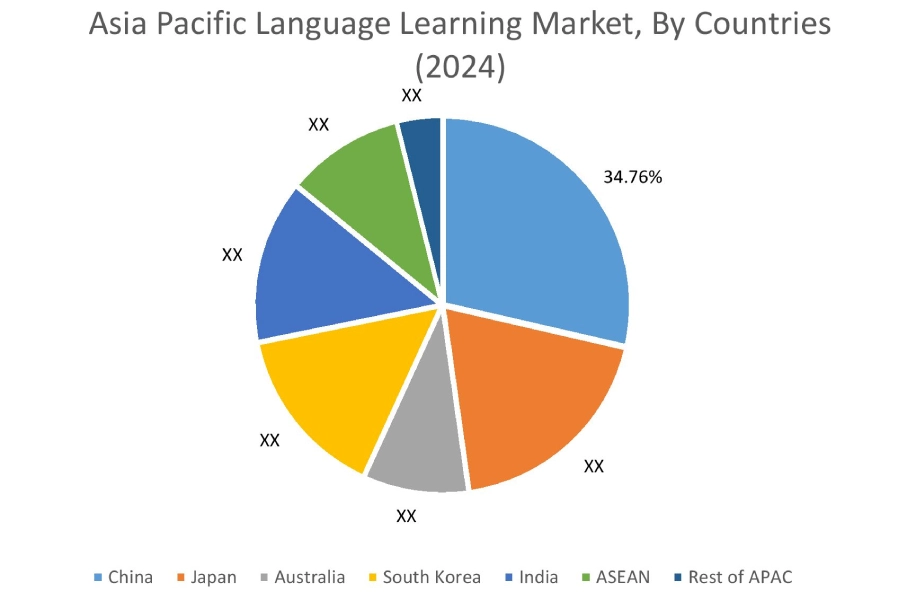
North America is estimated to reach over USD 34.17 Billion by 2032 from a value of USD 16.11 Billion in 2024 and is projected to grow by USD 17.39 Billion in 2025. In North America, the market growth is driven by the increasing development of learning applications and visual learning styles along with rising adoption of English language in the region. As per the analysis, the rising popularity of Spanish language and increasing adoption of Spanish learning courses are further contributing to the language learning market demand.
- For instance, according tothe National Centre for Education Statistics , Spanish was the most common home language of English learners in public schools, representing 76.4% of English learners in 2021. Thus, the above factors are boosting the market in North America.
Additionally, the regional analysis depicts that the prevalence of several international/foreign individuals and increasing adoption of native European language courses such as German, Dutch, Spanish, French, and others are driving the language learning market demand in Europe. Further, as per the market analysis, the language training industry in Latin America, Middle East, and African regions is expected to grow at a considerable rate due to increasing need for learning foreign languages, growing adoption of visual learning style, and rising penetration of online learning mode for remote learning, flexibility, and convenience.
Top Key Players and Market Share Insights:
The global language learning market is highly competitive, with major players providing solutions to the national and international markets. Key players are adopting several strategies in research and development (R&D), product innovation, and end-user launches to hold a strong position in the language learning industry. Key players in the language learning industry include –
- Duolingo, Inc. (U.S.)
- Coursera, Inc. (U.S.)
- Symbiosis Institute of Foreign Languages (India)
- Udemy, Inc. (U.S.)
- Lingoda GmbH (Germany)
- Transparent Language, Inc. (U.S.)
- University of Oxford (United Kingdom)
- University of California (U.S.)
- Babble GmbH (Germany)
- Mango Languages (U.S.)
Recent Industry Developments :
Product Launches:
- In April 2025, Duolingo announced the release of 148 new language courses on the app. Moreover, Duolingo expands its access to widely held languages, including Spanish, Japanese, French, German, and others.
Language Learning Market Report Insights :
| Report Attributes | Report Details |
| Study Timeline | 2019-2032 |
| Market Size in 2032 | USD 126.54 Billion |
| CAGR (2025-2032) | 10.8% |
| By Method |
|
| By Learning Style |
|
| By Language |
|
| By Mode |
|
| By Region |
|
| Key Players |
|
| North America | U.S. Canada Mexico |
| Europe | U.K. Germany France Spain Italy Russia Benelux Rest of Europe |
| APAC | China South Korea Japan India Australia ASEAN Rest of Asia-Pacific |
| Middle East and Africa | GCC Turkey South Africa Rest of MEA |
| LATAM | Brazil Argentina Chile Rest of LATAM |
| Report Coverage |
|
Key Questions Answered in the Report
How big is the language learning market? +
The language learning market was valued at USD 59.58 Billion in 2024 and it is projected to grow to USD 126.54 Billion by 2032.
Which is the fastest-growing region in the language learning market? +
Asia-Pacific is the region experiencing the most rapid growth in the language learning market.
What specific segmentation details are covered in the language learning report? +
The language learning report includes specific segmentation details for method, learning style, language, mode, and region.
Who are the major players in the language learning market? +
The key participants in the language learning market are Duolingo, Inc. (U.S.), Transparent Language, Inc. (U.S.), University of Oxford ( United Kingdom), University of California (U.S.), Babble GmbH (Germany), Mango Languages (U.S.), Coursera, Inc. (U.S.), Symbiosis Institute of Foreign Languages (India), Udemy, Inc. (U.S.), Lingoda GmbH (Germany), and others.
